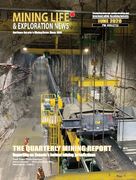Millennium Mine

Owner: Suncor Energy Inc.
P.O. Box 4001
The Millennium mine site is located near Fort McMurray in northern Alberta, Canada.
Suncor is an integrated energy company which pioneered the world's first commercially successful oil sands operation in 1967 near Fort McMurray, in northeastern Alberta. Today, with total production nearing the one billion barrel mark and enough reserves to sustain production for the next 50 years, the company remains a leader in oil sands development. Suncor Energy Inc. recovers bitumen from oil sand and upgrades it to refinery-ready feedstock (the raw crude oil fed to refineries for processing into transportation fuels and lubricants) and diesel fuel.
Suncor's Oil Sands Base operations include the Millennium and Steepbank (including North Steepbank Extension) open pit mining and extraction operations, two integrated upgrading facilities (Upgrader 1 and 2) , and the associated infrastructure - utilities, energy and reclamation facilities such as Tailings Reduction Operations (TRO) assets.
In late 2011, the company started to mine a new mining resource, the North Steepbank Extension (NSE). During the same year the company spent $622 million on the implementation of the TRO, and an additional $110 million on tailings drying facilities. The new hydrogen plant for the Millennium Naphta Unit (MNU) was operational for a short period in December 2011. The start of the naphta hydrotreater for the MNU is expected in 2012.
These growth projects are projected to produce a reliable, long-term energy supply while leveraging technology to minimize environmental and social impacts of resource development in the Athabasca region.
Alberta's oil sand is sand and rock which contains a heavy oil called bitumen. Oil sand is composed of approximately 70% sand and clay, 10% water, and anywhere from 0% to 18% oil. There are over one trillion barrels of bitumen in the Athabasca oil sands in an area of approximately 40,000 square kilometres.
Geology & Mineralization
Alberta's oil sand is sand and rock which contains a heavy oil called bitumen. Oil sand is composed of approximately 70% sand and clay, 10% water, and anywhere from 0% to 18% oil. There are over one trillion barrels of bitumen in the Athabasca oil sands in an area of approximately 40,000 square kilometres.
The sand was deposited in layers. Approximately 100 million years ago, streams flowed from the Rocky Mountains in the west and from the Precambrian Shield in the east. These streams brought sand and shale which filled in between the ridges running through Alberta and Saskatchewan. Eventually the area was the location of an ancient inland sea which spread the sand more widely. The sands became saturated with oil either because they were formed locally and never moved or because the oil flowed from elsewhere into the sand deposits.
The sand is a silica quartz and is extremely abrasive. The abrasive nature of the sand poses significant challenges in the mining and extraction of oil sand. The Athabasca Oil Sands are hydophillic. Each grain of sand is surrounded by a film of water, which is then surrounded by oil. The sands are held firmly together by grain to grain contact. This bond is broken in the hot water process.
Suncor's mining and in situ leases cover over 1,800 square km and contain nearly 13 bilion barrels of bitumen resources. The Base Mine and upgrader are located on the west bank of the Athabasca River and the Steepbank and Millennum Mines are on the east side of the Athabasca River. The Base Mine closed in 2002.
Suncor's Firebag in situ operation is located 40 kilometres northeast of the plant. In situ technology has the potential to recover large underground reserves. An independent evaluation of Suncor's in situ leases estimates recoverable resources with a potential to produce about nine billion barrels of crude oil.
P.O. Box 4001
Fort McMurray, Alberta
Canada
Phone:1 780 743 6411
Fax:1 780 791 8300

|